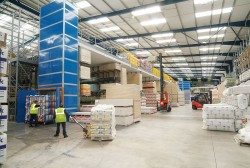The Green Construction Board work with Department for Business, Energy and Industrial Strategy (BEIS) and Defra to develop an interpretation of zero avoidable waste in construction and subsequently to develop a route map of how it might be delivered.
The result of this partnership is a new industry report, published in February 2020 – ‘Zero Avoidable Waste in Construction: what do we mean by it and how best to interpret it.’ As the report points out: ‘Zero Avoidable Waste’ in construction means preventing waste being generated at every stage of a project’s lifecycle, from the manufacture of materials and products, the design, specification, procurement and assembly of buildings and infrastructure through to deconstruction. At the end of life, products, components and materials should be recovered at the highest possible level of the waste hierarchy, i.e. reused before being recycled, whilst ensuring minimal environmental impact.
The role offsite manufacture plays in reducing waste across the construction sector is therefore huge. From the minimisation of waste material and recycling rates in the factory right through to the reduced time and less material waste on-site. Buildings can also be deconstructed at end of life for recycling or reuse – contributing to the circular economy.
“Going forward, the construction sector is changing as digitalisation and offsite manufacturing take greater prominence,” say Robert Pearce and Jane Thornback, Co-Chairs of the Green Construction Board Resources & Waste Task Group. “The Construction Sector Deal developed under the Industrial Strategy and agreed between industry and government seeks to develop a construction industry fit for the future using the most advanced techniques and delivering goals of greater productivity, new skills, lower carbon, and greater business opportunities.
“These new technologies will have a key role to play in helping to deliver a more resourceful and less wasteful industry, one that is able to design from the outset for more durable and adaptable buildings and structures and which help create a digital memory of what has gone into a structure, how it has been maintained, repaired or replaced and thus at end of life what materials are available for reuse, recycling or recovery.”
The construction sector is the largest user of materials in the UK and produces the biggest waste stream in terms of tonnage. Waste statistics collated by Defra show that in 2016, 63% (120 million tonnes) of the total waste stream in England (189 million tonnes) was attributed to construction, demolition and excavation waste. So understanding the ‘interplay between material choices’, carbon reduction, durability and adaptability must be underpinned by life-cycle assessment across the whole construction life-cycle.
At every stage of the construction process there are different opportunities for different professions in construction to reduce waste, and reuse or recycle products, components and buildings, and for materials to move up the ‘waste hierarchy’ so that ultimately material resources can continue to flow around a circular economy. These opportunities are available to clients, designers, material suppliers, product manufacturers, distributors and contractors.
Avoidable construction waste is interpreted as materials, products or components that can be prevented from becoming waste. Examples include designing out waste for new buildings by designing for better resource efficiency and for deconstruction and disassembly, efficient manufacturing processes, extending the life of buildings, disassembly for reuse and reducing surplus materials.
A key point is that the expected increase in offsite manufacturing could mean that more waste is recorded in statistics as being generated from manufacturing rather than classified in statistics as construction sector waste. The waste from each life cycle stage of the construction process is considered separately in terms of the waste types, the activity generating it, the ability for it to be avoided and/or recovered, along with the role of offsite delivery.
Waste from manufacturing activities will depend on the processes used, as it is often reused back into the manufacturing process and often not ever classified as a waste. This will include waste generated from offsite manufacture. With the move to more offsite manufacture, there is a need to understand the waste generated at the plant versus generated onsite. There may be more end of life issues for offsite systems, as they may have more complex materials/products combined that are harder to separate.
The Construction Sector Deal sets out an ambitious partnership between the industry and the government that aims to transform the sector’s productivity through innovative technologies and a more highly skilled workforce. The Sector Deal builds on Construction 2025, published by the government and the Construction Leadership Council in 2013, and provides the framework for a sector that delivers:
33% reduction in the cost of construction and the whole-life cost of assets
50% reduction in the time taken from inception to completion of newbuild
50% reduction in greenhouse gas emissions in the built environment –supporting the Industrial Strategy’s Clean Growth Grand Challenge
50% reduction in the trade gap between total exports and total imports of construction products and materials .
These goals will be met by focusing on three areas: digital techniques, offsite manufacturing and whole-life asset performance. The government and the sector are investing in the Industrial Strategy Challenge Fund (ISCF) Transforming Construction programme, as well as supporting training and infrastructure projects.
The report includes an in-depth discussion of the factors that have been considered to arrive at an interpretation of zero avoidable waste in construction and is set to inform a subsequent route map to be prepared by the end of 2020 to identifying recommendations and timescales for industry and government. Offsite manufacture is perfectly placed to capitalise on the central tenets of the circular economy and the natural reduction in waste via the efficient factory environment, Kanban system and component standardisation.
The Green Construction Board (GCB) is the sustainability workstream of the Construction
Leadership Council. For more information and to download a copy of the report: ‘Zero Avoidable Waste in Construction: What do we mean by it and how best to interpret it,’ visit: http://bit.ly/38RenxV
To view the whole magazine and read this article please click here: https://issuu.com/radarcommunications/docs/offsite_mag_issue_22_web/66









